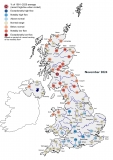Submitted by Steve Turner on
March was a changeable month: there were dry, sunny spells and some spring warmth for most, but also wet, blustery periods and wintry interludes in places. For the UK as a whole, March was mild (the joint fifth warmest for the UK in a record from 1910) and rainfall was near-average. While some northern and western areas were significantly wetter than average, south-east England was dry, and also saw the warmest temperatures – it was the second warmest March in a record from 1910 for the Southern and Anglian regions. With significant rainfall since mid-February, river flows in many upland catchments were above normal and, correspondingly, the last two months have seen delayed but welcome replenishment in most northern and western reservoirs. Steep increases have returned stocks to near- or above-average for the first time since the autumn in many impoundments, and March stocks were near-average at the national scale. However, stocks remained >10% below average at Bewl and Roadford in southern England. In south-east England, the modest winter half-year recharge is evident in below-normal groundwater levels across much of the Chalk outcrop. With early April also seeing little rainfall in the English Lowlands, significant recovery is unlikely before evapotranspiration rates climb steeply in late spring. Low groundwater levels (and low flows in some groundwater-fed rivers) may be expected to persist in parts of south-east England and could lead to some localised pressures on water resources later in the year.
Read the full Summary here.



